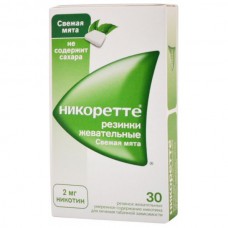Expiration date: 11/2026
The composition and form of issue:
Solution for inhalation absorbed 1 cartridge
nicotine 10 mg
(4 mg of the released substance)
excipients: levomenthol 1 mg ethanol (evaporates during the production process) — 133 mg nitrogen q.s.
a porous cylinder — 1 PC.
in blister packs of 6 cartridges in the stack of cardboard 1, 3 or 7 blisters in a kit with a mouthpiece.
Chewing gum 1 pillow
nicotine (nicotine-polymeric complex of 20%) 2 or 4 mg
excipients: chewing gum base sorbitol powder sorbitol 70% sodium carbonate anhydrous sodium hydrogen carbonate additive for aromatic smokers 84,6422 glycerol 85% food dye quinoline yellow dye talc nitrogen
blistere in 15 PCs. in cardboard pack 1, 2, 7 or 14 blisters.
Chewing gum 1 pillow
(with mint flavor)
nicotine (nicotine-polymeric complex of 20%) 2 or 4 mg
excipients: chewing gum base xylitol, sodium carbonate anhydrous, peppermint oil sodium bicarbonate levomenthol magnesium oxide quinoline yellow dye talc nitrogen
blistere in 15 PCs. in cardboard pack 1, 2, 7 or 14 blisters.
Description pharmaceutical form:
Solution for inhalation: white or light colored porous cylinder in a sealed, transparent, plastic cartridge with the inscription "NICORETTE" and specified number series.
Chewing gum: square pads beige (yellow for dosage 4 mg) color size approx 14 x 14 x 5 mm.
Chewing gum with mint flavor: square pads are a light beige (light yellow — for the dose of 4 mg) color size approx 14 x 14 x 5 mm with a characteristic minty smell.
Indications:
Nicotine withdrawal when quitting Smoking.
Side effects:
Hypersalivation, pain or irritation of the tongue, ulceration of the oral mucosa, flatulence, rumbling in the intestines, hiccups, nausea, vomiting, dizziness, headache. Side effects such as headache, dizziness, sleep disturbance may be a manifestation of abstinence syndrome, and indicate an insufficient dose of nicotine.
Method of application and dose:
Solution for inhalation.
Cartridge, part of the Nicorette inhaler, is a porous plastic cylinder, equipped with both ends of the protective covering of aluminum foil. Before use, the cartridge is inserted into the mouthpiece, wherein the protective cover is automatically opened.
The Nicorette inhaler is used in inhalation the moment when there is an overwhelming desire to smoke. The dosage is selected individually, taking into account the severity of nicotine addiction in a patient. You should not use more than 12 cartridges a day for 6-12 weeks. Using inhaler are given the opportunity to prevent or at least minimize various kinds of unpleasant sensations (the so-called symptoms of "cancellation"), continuing for some time to inhale small amounts of nicotine. When air is inhaled through the inhaler, nicotine is vaporized and absorbed in the oral cavity. The absorption of nicotine is slow, and thus can not quickly created high concentration of nicotine in plasma, as when Smoking. In addition, unlike cigarettes, the inhaler does not contain tar and carbon monoxide.
Adults, including elderly patients, the recommended dose is 6-12 cartridges per day. 1 cartridge replace 4 cigarettes. When Smoking 20 cigarettes a day, use 6 cartridges per day. Each cartridge uses about 4 doses, the duration of each of which is about 20 min.
Complete cessation of Smoking.
Inhaler used for 3 months (at least). Then gradually reduce the number of used cartridges. It is recommended to have a few extra cartridges, because there can be unexpected desire to smoke.
Reducing the number of cigarettes smoked.
The inhaler is used in between Smoking to increase their duration and for the greatest possible reduction in the number of cigarettes smoked. If after 6 weeks the number of daily cigarettes smoked has not declined, you should seek the advice of a specialist.
Attempt to quit Smoking should be taken not later than 6 months after the start of treatment. If within 9 months of failed to quit Smoking should seek the advice of a specialist.
Do not use the inhaler more than 6 months.
Chewing gum.
The gum should be chewed slowly for 30 min. If the patient smokes 20 or less cigarettes per day, are shown chewing gum Nicorette in the dose of 2 mg, more than 20 cigarettes in a dosage of 4 mg.
Nicorette should be used in all cases where there is an overwhelming desire to smoke according to the following scheme: 1 — slowly chew the gum until the sharp taste, 2 — stop chewing and keep the gum between the inner side of the cheeks and gums, 3 — when the taste disappears, you can start to chew gum again.
Repeat this circuit should be approximately 0.5 hours to Approximately 30 minutes after the beginning of the respective use in the gum is no nicotine. Usually used about 10 pads a day. You should not use more than 1 paw at a time and more than 15 pads a day. If the day takes longer than 15 pads 2 mg, it is recommended to go to the dosage to 4 mg.
Complete cessation of Smoking.
The gum should be chewed in accordance with the instructions, as soon as there is an overwhelming desire to smoke, to maintain a state of complete Smoking cessation. Every day you should apply a sufficient amount of pads, usually 8-12 pieces, maximum 15 pieces Nicorette need to use in the first 3 months after quitting Smoking. You then gradually reduce the number of used gum. When the daily intake of gum will decrease to 1-2 pads, the use of the drug should be discontinued. However, one should always keep in reserve some quantity of the drug, because suddenly may again be tempted to smoke.
Usually do not use for more than 12 months (some may need longer treatment to prevent a return to Smoking).
Reducing the number of cigarettes smoked.
Chewing gum should be used between Smoking episodes to lengthen the interval between Smoking of cigarettes, to reduce cigarette consumption. If within 6 weeks failed to reduce daily use of cigarettes, you should seek the assistance of a specialist.
Attempt to quit Smoking should be taken not later than 6 months after the start of therapy. If you could not make a serious attempt to stop Smoking within 9 months after the start of therapy, refer to specialist.
Regular use of chewing gum for more than 12 months is generally not recommended (some ex-smokers may need longer treatment).
Simultaneous, health counseling and provision of psychological support usually improve the effectiveness of therapy.
Temporary Smoking cessation.
Chewing gum can be used in periods when it is necessary to refrain from Smoking, for example while in places where Smoking is prohibited, or in other situations where you need to refrain from Smoking.
Chewing gum with nicotine should not be administered to persons younger than 18 years old without the advice of a physician.
Precautions:
Care must be taken in diseases of the temporomandibular joints (acute) serious cardiac arrhythmias, systemic hypertension, vasospastic diseases (including severe angina pectoris), recently moved myocardial infarction gastric ulcer and duodenal ulcer, esophagitis (acute) inflammatory diseases of the mouth and throat pregnancy, breast-feeding, childhood.







